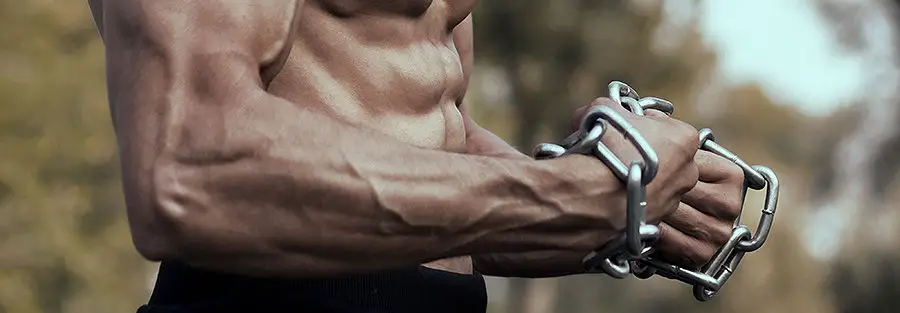
Having thick, strong wrists can enhance your arms’ overall look, but it can be troublesome to figure out how to get thicker wrists.
Your wrists are limited to their size once fully grown. However, you can make your wrists stronger and look a bit thicker by exercising your wrists.
What Determines Wrist Size?
Genetics
The main factor that determines the majority of your bone measurements is your genetics. If one or both parents have thicker body frames, particularly in the wrists, you may get thick wrists.
The body frame that you get from your genes usually determines your natural wrist size. For instance, a man who is 5’5” and has 7.5-inch wrists would have a large body frame.
Nutrition
Nutrition may play a factor in your natural wrist size, but your genes mostly determine your wrist size. However, nutrition is essential to focus on when you try to make your wrists bigger.
Bones are made of many nutrients, such as calcium, vitamin D, and such (Price et al., 2012). You should make sure you consume enough protein as well to encourage muscle growth and strength. Good foods in this category include yogurt, bone broth, cruciferous vegetables, etc.
Why Does My Wrist Size Matter?
People often use wrist measurements along with height to determine the body’s frame size. If you have somewhat large wrists, it often means that you have a medium or large body frame. It is often more desirable for a man to have a larger body frame.
For instance, if a man is 5’8” and his wrist size is 7.5-8 inches, he has a large body frame. However, if the man is 5’8” and has a wrist size of 5.5-6.5 inches, it means he has a small body frame.
Additionally, thicker wrists can be more attractive on men, especially when paired with strong forearms and upper arms.
Is It Possible to Make My Wrist Bones Thicker?
Technically, you cannot make your wrist bones thicker (unless there is excess fat in that area). The wrist is composed of ligaments/tendons and bones, so it would be difficult to pack muscle on there.
However, you can increase your wrists’ bone density to potentially prevent bone loss when you age. Additionally, wrist exercises can make your wrists and forearms stronger. If you work out your wrists and forearms enough, it could potentially make your wrists look thicker.
How to Get Thicker Wrists
Warm-Up
Before you jump into wrist exercises, it is important to warm up. Warming up your muscles is essential and will help prepare your body and prevent injuries. It does not matter if you exercise frequently. It would be best if you did warm-ups regularly.
Wrist Rolls
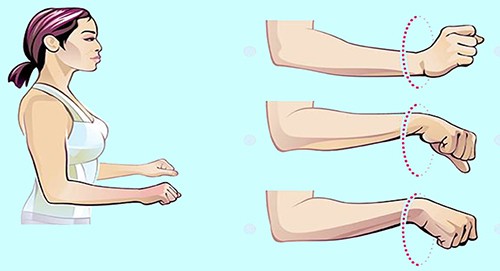
Make a fist using each hand, like in the photo above. Rotate your wrists slowly clockwise, counter-clockwise, backward, forward; pretty much any possible way to warm up your wrists. You can do this warm-up for 30-60 seconds or longer if you would like.
Prayer Stretch
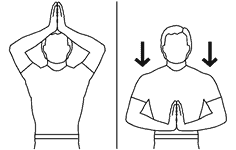
Bend your elbows in front of you like the photo above (you may put them in front of your face if that is more comfortable), and keep your palms pressed together in a prayer position.
Lower your hands slowly towards the ground until you feel a slight stretch in your wrists and forearms, then return to the first position.
You can do 7-10 reps of these for 1-3 sets, but you can adjust the reps and sets.
Wrist Exercises
You can do a mixture of any of the exercises listed below. Ideally, you should choose at least 4-5 exercises; you will either overexert yourself if you do more or underwork yourself if you choose less.
Beginners can choose three exercises for the first few days, then slowly add more exercises. You could also try four exercises and do only two sets with 4-6 reps per exercise.
Knuckle Push-Ups
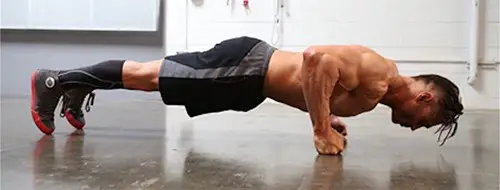
These push-ups are very similar to regular push-ups; the main difference is that you have your hands in a fist with your knuckles on the floor instead of pressing your palms straight onto the ground. You can do this for 20-30 reps for 2-4 sets, but you can adjust that amount as needed.
Remember, you should keep your thumbs inside of your wrists when you do knuckle push-ups. It will help you avoid injury.
If you find it hard to do regular knuckle push-ups, you can focus on doing knee push-ups first. Get into a similar position as the knuckle push-up, but with your knees slightly bent and touching the floor.
You can do knee push-ups until you reach 20-30 rep sets. Once you reach that, you can move on to traditional or knuckle push-ups.
Click here to watch a video about how to do a knuckle push-up.
Extensions and Curls
If you already go to the gym, it is pretty likely that you already do these exercises for arm day. But you can add another set to your usual workout routine or do a few sets when you workout your wrists.
The goal for most of your wrist exercises would be to aim for hypertrophy, which is an increase and growth of muscle cells. An excellent way to achieve hypertrophy is by lifting weights (i.e., doing curls and extensions to work your forearms and wrists).
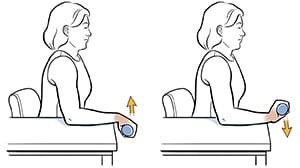
To do wrist extensions, grab any weight you are comfortable with and rest your forearms flat on a surface, like your thighs or a bench. Keep your palms facing down with your hands hanging. Lift your hands upward without moving anything else and repeat.
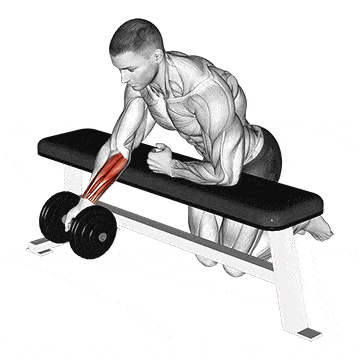
For wrist curls, start in the same position as wrist extensions but with your palms facing up. Get a weight, then lift your hands toward the ceiling without moving anything else.
You can do 3-5 sets of 8-12 reps of each of these. It is easy to adjust this as needed; you could try three sets of twelve reps or five sets of eight reps.
It is possible to do this workout without weights. However, using a weight will help you increase your wrist size faster. If you are new to exercising, you can start without weights for 1-2 weeks, then add a small weight. You can gradually add weight once it feels easy for you.
However, you can also amp up the knuckle push-ups if you find them too easy. Instead of having your wrists shoulder-width apart, keep them closer together or further apart. Or, you could rotate your wrists 90-degrees outward.
Hand Grips
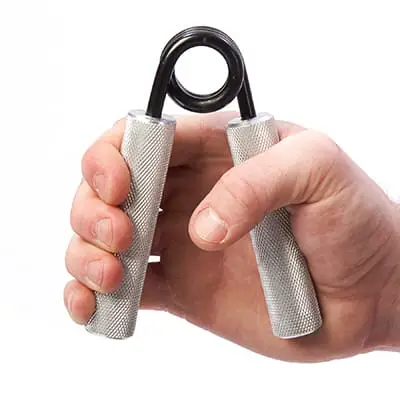
A useful piece of workout gear that you can get are hand grips. It is an excellent option if you do not have a lot of space for workout equipment; hand grips are usually very affordable and small.
Keep in mind that you should avoid overusing hand grips. Use it slowly and start with 5-7 reps for 2-3 sets. You could be extremely sore or sprain your wrists if you overexert yourself.
Plate Pinches
If you have plates from a weight machine, you can use them for your wrist routine. Plate pinches focus on your grip and forearms, making them an excellent addition to a wrist workout.
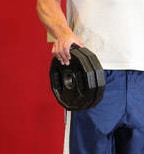
Line up 1-2 plates on the floor in front of you; the plates should be perpendicular to the floor. Squat down, then grip the plates using your thumb and index finger. Securely hold them as you stand up. Squat back down, release the plates, then repeat.
Alternate your hands when you do plate pinches. You can try to aim for 5-10 reps of 3 sets, but you can adjust that as needed.
Click here to watch a video about how to do plate pinches.
Don’t have weight plates in your house? You can swap them out for thick books instead. Grab a few heavy, thick books; the width should stretch out your thumb and index finger without being painful. While it may not give you the same weight as plates would, it helps you focus on your grip if you do not have plates lying around.
Deadlifts, Pull-Ups, and Chin-Ups
These exercises are excellent for wrist thickening because you squeeze the bar hard with a lot of weight (either yourself or with plates). The exercises focus a lot on your forearms, which will lead to stronger and thicker wrists.
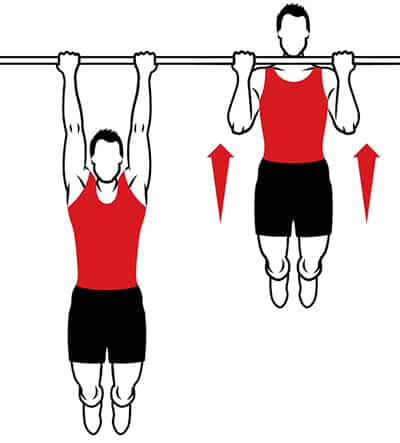
Chin-ups: Chin-ups are fantastic for working out your biceps.
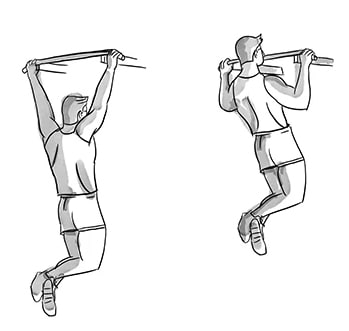
Pull-Ups: Pull-ups focus on your upper back, enhancing your posture when you stand.

Deadlifts: Deadlifts hit almost every major muscle group, like your back muscles, glutes, abs, thighs, etc.
When you do any of these exercises and want to grow thicker wrists, you need to squeeze the bars as hard as possible. Squeezing the bar will help you get your wrists and forearms stronger.
How many reps and sets you do will depend on you. Some people may not be able to do one full pull-up right away, so it is all about listening to your body.
Cool Down
As stated earlier, it is important to warm-up and stretch your wrists before exercising them. The same thing should go for cooling down your wrists. Cooling down your wrists after a workout can help your forearm and wrist muscles relax and decrease how sore you will be the next day.
To cool down your wrists, you can repeat the exercises mentioned earlier for the warm-up. You can focus on doing wrist rolls especially to “loosen” any tight feeling in your wrists. Make sure to do these stretches slowly; rushing through the stretches can lead to injury.
How Often Should I Do Wrist Exercises?
First, it depends on your strength level. If you are a beginner, you should not strain yourself that much. Pushing yourself too hard can be dangerous and lead to injuries.
Beginners should pick 3-4 exercises and do 1-2 sets of each workout first, with about 40-120 seconds of break between each set. Of course, you should take more frequent breaks or stop when you feel pain or excessive strain in your wrists.
Intermediates can bring up their reps or sets; it is mostly a matter of listening to your body. Once you feel like your usual sets feel like nothing, try to increase how many sets or reps you do to challenge yourself.
As for how many days you should do the exercise, that will also depend on you. However, beginners and fitness experts may be fine with doing these exercises 1-3 times a week.
It may not be wise for most people to try these exercises every day. Overexerting your wrists can lead to injuries, which definitely would get in the way of making your wrists thicker and stronger.
It is also important to note that your wrists can only grow so much. The wrists have a limit to how much muscle they can grow. Your wrists are mostly joints where your muscles are attached to.
For instance, you can grow your biceps by working them out because you can easily activate those muscles. However, you technically have no real wrist muscles, so, likely, you will not go up a full wrist size no matter how much you exercise.
However, the exercises listed above give your forearms a good work out. Training the forearms to be stronger and bigger can make your wrist bones thicker. While it may be minimal, it can still improve your wrists if you are consistent.
Example Routines
Beginner (2-3 times a week)
- Hand Grips: 2 sets, 4-5 reps
- Wrist Extensions (without weights): 2 sets, 8-10 reps
- Wrist Curls (without weights): 2 sets, 8-10 reps
- Knuckle/Regular Push-Ups: 20-30 reps
Intermediate (2-4 times a week with 1-2 days break between each day)
- Wrist Extensions (with light-medium weights): 2 sets, 8-10 reps
- Wrist Curls (with light-medium weights): 2 sets, 8-10 reps
- Plate Pinches (with light-medium weights): 2 sets, 4-7 reps per hand
- Pull-Ups: 7-15 reps (as many as you can do before your wrists feel strained) OR Knuckle Push-Ups: 15-25 reps (as many as you can do before your wrists feel strained)
Advanced (2-4 times a week with 1-2 days break between each day)
- Wrist Extensions (with medium-heavy weights that do not strain your wrists): 2-3 sets. 4-7 reps
- Wrist Curls (with medium-heavy weights that do not strain your wrists): 2-3 sets. 4-7 reps
- Plate Pinches (with medium-heavy weights that do not strain your wrists): 2-3 sets, 4-7 reps per hand
- Pull-Ups/Chin-Ups: 10-15 reps
- Knuckle Push-Ups: 25-40 reps (as many as you can do before your wrists feel strained) OR Deadlifts (with a weight you are comfortable with): 2-3 reps, 4-7 reps

